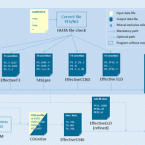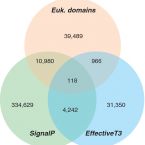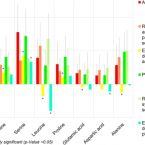Publications
The fulltext of publications might not be freely accessible but require subscription. Please request reprints at contact.cube@univie.ac.at.
Publications in peer reviewed journals
EffectiveDB-updates and novel features for a better annotation of bacterial secreted proteins and Type III, IV, VI secretion systems.
2016 - Nucleic Acids Res., D669-74
Abstract:
Protein secretion systems play a key role in the interaction of bacteria and hosts. EffectiveDB (http://effectivedb.org) contains pre-calculated predictions of bacterial secreted proteins and of intact secretion systems. Here we describe a major update of the database, which was previously featured in the NAR Database Issue. EffectiveDB bundles various tools to recognize Type III secretion signals, conserved binding sites of Type III chaperones, Type IV secretion peptides, eukaryotic-like domains and subcellular targeting signals in the host. Beyond the analysis of arbitrary protein sequence collections, the new release of EffectiveDB also provides a 'genome-mode', in which protein sequences from nearly complete genomes or metagenomic bins can be screened for the presence of three important secretion systems (Type III, IV, VI). EffectiveDB contains pre-calculated predictions for currently 1677 bacterial genomes from the EggNOG 4.0 database and for additional bacterial genomes from NCBI RefSeq. The new, user-friendly and informative web portal offers a submission tool for running the EffectiveDB prediction tools on user-provided data.Prediction of microbial phenotypes based on comparative genomics.
2015 - BMC Bioinformatics, S1
Abstract:
The accessibility of almost complete genome sequences of uncultivable microbial species from metagenomes necessitates computational methods predicting microbial phenotypes solely based on genomic data. Here we investigate how comparative genomics can be utilized for the prediction of microbial phenotypes. The PICA framework facilitates application and comparison of different machine learning techniques for phenotypic trait prediction. We have improved and extended PICA's support vector machine plug-in and suggest its applicability to large-scale genome databases and incomplete genome sequences.Effective--a database of predicted secreted bacterial proteins.
2011 - Nucleic Acids Res., D591-5
Abstract:
Protein secretion is a key virulence mechanism of pathogenic and symbiotic bacteria, which makes the investigation of secreted proteins ('effectors') crucial for understanding the molecular bacterium-host interactions. Effective (http://effectors.org) is a database of predicted bacterial secreted proteins, implementing two complementary prediction strategies for protein secretion: the identification of eukaryotic-like protein domains and the recognition of signal peptides in amino acid sequences. The Effective web portal provides user-friendly tools for browsing and retrieving comprehensive precalculated predictions for whole bacterial genomes as well as for the interactive prediction of effectors in user-provided protein sequences.
Targeting effectors: the molecular recognition of Type III secreted proteins.
2010 - Microbes Infect., 5: 346-58
Abstract:
The Type III secretion system (TTSS) facilitates the export of effector proteins from pathogenic and symbiotic Gram-negative bacteria into the cytosol of eukaryotic host cells. The current functional and evolutionary knowledge on the molecular recognition of TTSS substrates and computational models of the secretion signal are discussed in this review.
Sequence-based prediction of type III secreted proteins.
2009 - PLoS Pathog., 4: e1000376
Abstract:
The type III secretion system (TTSS) is a key mechanism for host cell interaction used by a variety of bacterial pathogens and symbionts of plants and animals including humans. The TTSS represents a molecular syringe with which the bacteria deliver effector proteins directly into the host cell cytosol. Despite the importance of the TTSS for bacterial pathogenesis, recognition and targeting of type III secreted proteins has up until now been poorly understood. Several hypotheses are discussed, including an mRNA-based signal, a chaperon-mediated process, or an N-terminal signal peptide. In this study, we systematically analyzed the amino acid composition and secondary structure of N-termini of 100 experimentally verified effector proteins. Based on this, we developed a machine-learning approach for the prediction of TTSS effector proteins, taking into account N-terminal sequence features such as frequencies of amino acids, short peptides, or residues with certain physico-chemical properties. The resulting computational model revealed a strong type III secretion signal in the N-terminus that can be used to detect effectors with sensitivity of approximately 71% and selectivity of approximately 85%. This signal seems to be taxonomically universal and conserved among animal pathogens and plant symbionts, since we could successfully detect effector proteins if the respective group was excluded from training. The application of our prediction approach to 739 complete bacterial and archaeal genome sequences resulted in the identification of between 0% and 12% putative TTSS effector proteins. Comparison of effector proteins with orthologs that are not secreted by the TTSS showed no clear pattern of signal acquisition by fusion, suggesting convergent evolutionary processes shaping the type III secretion signal. The newly developed program EffectiveT3 (http://www.chlamydiaedb.org) is the first universal in silico prediction program for the identification of novel TTSS effectors. Our findings will facilitate further studies on and improve our understanding of type III secretion and its role in pathogen-host interactions.



